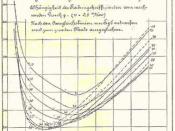Abstract: Using a simple pulley system, consisting of a stationary block with attached string, suspending a weight of variable mass, we will demonstrate the principles of kinetic and static friction. Our goal is in determining coefficient of static and kinetic friction, using the following two equations: sF and k = m2g "ÃÂ (m1 + m2) a N Fn In a series of trials, the average block normal force is found to be 0.48(g), with an average external force of 0.349(g), yielding an average coefficient of static friction of 0.727. Repeating the same test with a non-stationary block, with the minimum external force for continued movement, block acceleration was monitored. The average values of block mass, external force, and acceleration were 458g, 356g, and 1.28m/sec2 respectively. This yielded an average coefficient of kinetic friction of 0.504.
Introduction: Whenever the surface of one body is in contact with the surface of another, each body may exert a frictional force on the other.
The direction of this force is parallel to the surfaces in question and is directed opposite to any force or motion involved. (Lab Manual 11) This opposing force is the topic of discussion for this lab.
Frictional forces present between a sliding object and the surface upon which it is sliding can effect its tendency to remain stationary, continue in motion, and accelerate or decelerate from motion. Through careful measurement of the forces [F] required to move an object from rest, as well as that object's normal force [N] (weight), the coefficient of static friction [] can be determined. This relationship is expressed by the equation F N Kinetic coefficient of friction can be found by using this equation as well. However [F] denotes the force required to maintain the object's motion once it has overcome static friction and is...


